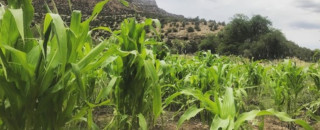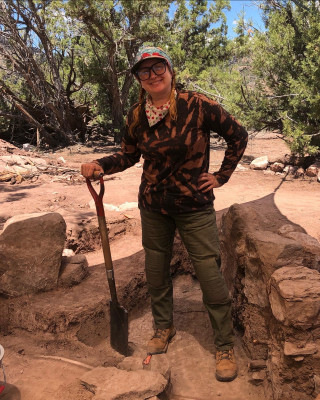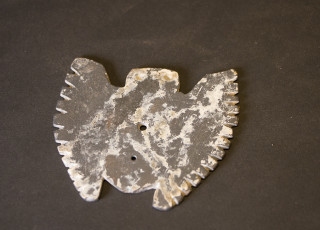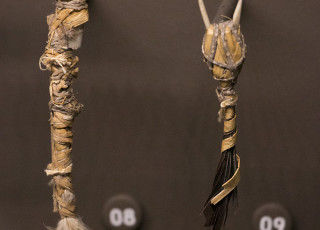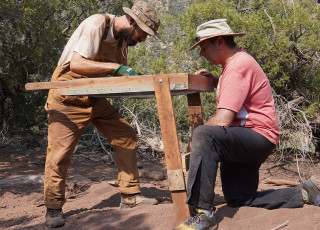New Study Explores How Utah's Fremont Farmers Watered Their Crops
Maize stalks growing in the Range Creek Canyon irrigation experiment. Credit: Ellyse Simons
By Riley Black
Water can be a finicky thing in the West. In a good year, winter snowpack and spring rains refresh the landscape. In a dry one, everything seems to wither to a crisp and the threat of wildfires grows. Now consider how all this affects growing crops, not just in our present time but for the people who called Utah home for thousands of years. Irrigation has long been the solution to keeping crops watered in the critical seasons, and an experiment conducted by Natural History Museum of Utah archaeologists provides a detailed look at how Fremont farmers may have decided to cultivate their crops.
Hundreds of years ago, people belonging to the Fremont culture lived in what’s now Range Creek Canyon, Utah. And among the many things they did in this place was grow crops like maize. Being able to divert some water from Range Creek itself for irrigation seems like it would have benefitted these farmers, so, to find out, Museum archaeologists carried out irrigation experiments over five years to determine the costs and benefits of undertaking such a project.
The new study, published in American Antiquity by Shannon Boomgarden, Duncan Metcalfe, and Ellyse Simons, analyzes the results of a five-year irrigation experiment conducted in Range Creek Canyon between 2013 and 2017. What the researchers found was that even in a relatively wet year, there can still be benefits to irrigation.
Conducting the study in Range Creek was an obvious choice. Not only does the canyon boast “the most spectacularly-preserved archaeological sites ever discovered that document the Fremont foragers and farmers who lived there 900 years ago,” Boomgarden says, but it’s also the home of the Museum’s field station. These facilities allow researchers and students to come back year after year to conduct long-term studies that aren’t possible elsewhere, tracking differences and learning more from season to season and year to year. “Taken together,” Boomgarden says, “Range Creek provides a unique opportunity to systematically explore the range of options available to the Fremont who made this canyon their home, and to quantify the costs and benefits of each of those options using actualistic and experimental research.”
In this case, Boomgarden and colleagues ran two sets of experiments in Range Creek. The first was to track how adding water by irrigation affected maize plots, and the second considered the time and effort that goes into constructing and maintaining crop irrigation using only simple tools of the sort the Fremont made.
Not that the research was easy. Racoons, rabbits, horses, and grasshoppers raided the maize plots during three of the five years of the study, meaning Boomgarden and colleagues had to calculate what had grown from what the bandits left behind. Still, the data collected from the dual experiments was enough to allow the archaeologists to calculate how and when irrigating crops is a good strategy among people who have the option of spending more time farming or foraging.
Much of this comes down to time and effort, and how to get the most back for what people put in to a pursuit. Farming isn’t just one activity, Boomgarden says, but involves a range of requirements. “Fields have to be cleared, crops planted, weeded, perhaps irrigated, pests have to be controlled, the crop harvested and then prepared into meals.” It’s difficult and enduring work, and involves natural circumstances like whether there is even enough water at a nearby source to douse the plots.
Some of those challenges only became apparent in trying to recreate what the Fremont coped with. “There has not been an easy year even when plenty of water was flowing in the creek,” Boomgarden says, noting problems selecting the right maize, flooding, and pests, with many of the difficulties being out of the researchers’ control. “We learned that actualistic studies force you to recognize the full range of factors that simple farmers face,” Boomgarden says. Yet, for all the struggle, there was a payoff in the field as well as what the experiments revealed.
The conditions in Range Creek today are about as dry as they were as when the Fremont lived there. “Based on tree-ring reconstructions of the weather during the Fremont times from neighboring Nine Mile Canyon, things were not better in the past,” Boomgarden says. The environment was dry, and raising a maize harvest would have required irrigation. But the time spent in constructing and maintaining irrigation from Range Creek would have been worth it. “The most important result of our research is the demonstration that irrigating in arid regions is not only necessary, but it is profitable in terms of its benefits, or harvest, relative to its costs, such as time required,” Boomgarden says. This is true even in areas that seem fairly moist, like floodplains. “Even when sufficient precipitation is available to grow crops,” Boomgarden says, “irrigating those fields may increase the harvest more than enough to cover the additional costs of irrigating.”
This isn’t just about the past. “In a world where populations are increasing, access to water in at least some regions is becoming tighter, and the Earth warming, farming is becoming and will become increasingly risky,” Boomgarden says. From the results of the farming experiments, then, it seems that irrigating more wisely on a wider acreage instead of trying to get the maximum return on every acre might help make the most of a diminished water supply. By looking to the past, we can make better-informed decisions about the future.
Riley Black is the author of Skeleton Keys, My Beloved Brontosaurus, Prehistoric Predators, and a science writer for the Natural History Museum of Utah, a part of the University of Utah in Salt Lake City. Our mission is to illuminate the natural world and the place of humans within it. In addition to housing outstanding exhibits for the public, NHMU is a research museum. Learn more.
